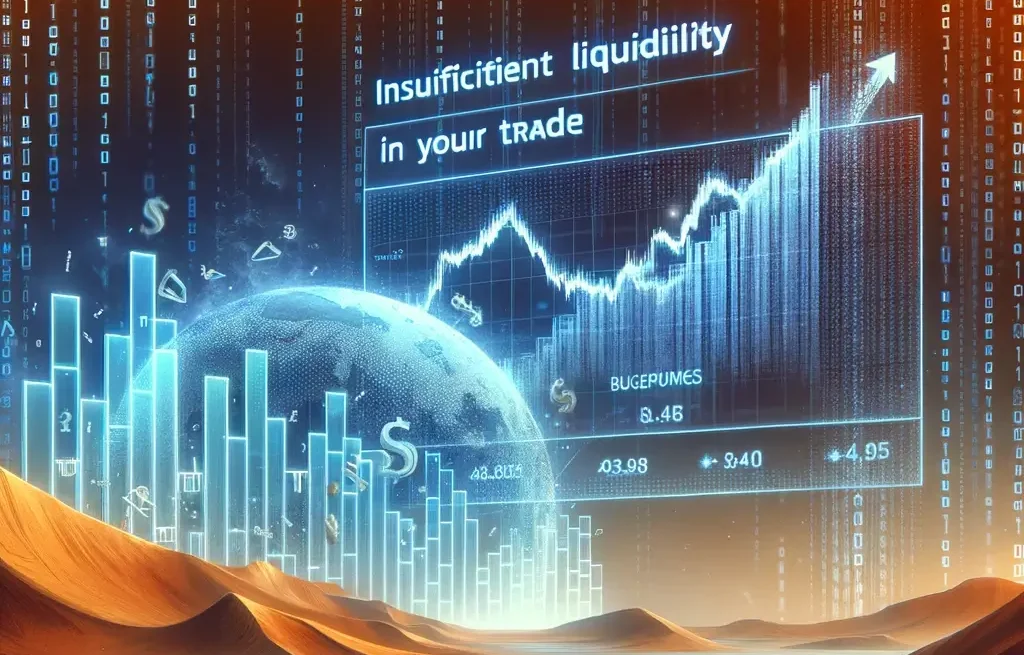In the exciting and rapidly evolving decentralized finance (DeFi) world, trading platforms like PancakeSwap and Uniswap have gained immense popularity. Yet, as many traders have come to learn, utilizing these platforms can sometimes lead to complications.
One such complication, which can be frustrating for newcomers and seasoned traders alike, is the “Insufficient Liquidity for This Trade” trade error. This article aims to demystify this trade error and message, explain what “insufficient liquidity for this trade error” means, and provide practical solutions for resolving it.
Understanding Insufficient Liquidity
Before we delve into the nuts and bolts of resolving the “Insufficient Liquidity for This Trade” issue, it’s crucial to understand what it means. In essence, “insufficient market liquidity for this trade” refers to a situation in financial markets where there aren’t enough specific assets in a total market liquidity pool to facilitate a trade.
Liquidity pools are the backbone of the trading part of decentralized exchanges (DEXs) like PancakeSwap and Uniswap. They are essentially smart contracts that contain reserves of two traded tokens. When trading, you perform a swap transaction and interact with these reserves.
Therefore, when a trader encounters the “insufficient liquidity” error, it indicates there aren’t enough reserves of certain traded tokens of a specific exchange token to complete the swap transaction at the correct token or desired price.
Insufficient Liquidity on PancakeSwap and Uniswap

Both PancakeSwap and Uniswap use automated market maker (AMM) models. This is an automated market maker, which means that the ratio of the tokens in front fixes the insufficient liquidity for trades to fix insufficient liquidity or the inadequate liquidity pool, which determines the price of the tokens.
When a user encounters a “PancakeSwap Insufficient Liquidity for This Trade” or “Uniswap Insufficient Liquidity for This Trade” error, it’s typically because the amount of tokens they want to swap significantly affects the token ratio in front to fix insufficient liquidity for this trade, the fix insufficient liquidity for pool, or fix insufficient liquidity for constraints, which in turn would drastically shift the token price.
Given the liquidity constraints and the decentralized nature of these platforms’ decentralized exchanges, anyone can create a liquidity pool for trades of any pair of assets or tokens. However, suppose the pool has insufficient liquidity for this trade and is not adequately funded. In that case, traders and decentralized exchanges may encounter the “Not Enough Liquidity Found for This Asset Pair” error.
Solving Insufficient Liquidity Errors
Now that we’ve covered what “insufficient liquidity” means fix the insufficient liquidity. Let’s discuss how to fix the insufficient liquidity and resolve it.
1. Adjust Trade Size
The simplest solution to fix the issues of insufficient liquidity and inadequate liquidity pools is to adjust your trade size. Large transactions can dramatically affect the token ratio and price if you deal with a low-liquidity pool. By reducing your trade size, you decrease its impact on the liquidity constraints of the pool, potentially allowing your trade to go through.
2. Check Other Pools
Another approach is allowing users to check for other liquidity pools for the same token pair. On Uniswap and PancakeSwap, different liquidity pools may exist for the same pair of tokens. Users of decentralized platforms may have created these liquidity pools themselves or use different Uniswap or PancakeSwap protocol versions.
Different pools have different liquidity levels for certain tokens or trading-specific tokens, so checking multiple pools for certain tokens could help you find one with sufficient liquidity for this trade.
3. Adjust Slippage Tolerance
Slippage refers to the difference between the expected price of a trade and the price at which the trade is executed — high-price to experience significant slippage that often occurs in low-liquidity pools. In PancakeSwap and Uniswap, you can adjust your price to the slippage settings to increase your slippage settings tolerance and tolerance.
Increasing your price to increase your slippage settings and tolerance may allow your trade to go through, but be aware that this could result in a less favorable expected price again.
4. Wait for More Liquidity
If the above options don’t work, you may have to wait for more liquidity-specific tokens to be added to the pool by other traders depositing more tokens to centralized exchanges or liquidity providers. The crypto market is dynamic, and liquidity, exchange, and certain token levels can change rapidly.
5. Become a Liquidity Provider
Suppose you frequently encounter the “insufficient or insufficient liquidity amount” trade error and have many tokens involved in the same trade error. In that case, you might consider the first solution: becoming a liquidity provider (LP).
By depositing your tokens into the pool, you increase liquidity for this trade, potentially solving your trade error problem and earning LP fees. However, being an LP comes with its risks, such as liquidity issues and impermanent loss, so it’s essential to thoroughly research and understand these risks before choosing this route.
Specific Considerations for PancakeSwap and Uniswap
Despite their similarities, PancakeSwap and Uniswap operate on different blockchain networks: Binance Smart Chain (BSC) and Ethereum. This difference can influence the purchase amount of each fix, the amount fix insufficient liquidity or enough liquidity available for trades in specific tokens on the pools and exchanges, and, consequently, the frequency of successful trades without encountering the trading error, the “insufficient liquidity” trading error.

In the case of PancakeSwap, due to, for example, the lower transaction fees on BSC, users may be more willing to make new tokens to add liquidity to the liquidity pools than swap tokens themselves, potentially reducing the chances of running into an “insufficient liquidity” error.
On the other hand, Ethereum’s higher gas fees can deter users from frequently contributing new tokens to the liquidity pools, possibly leading to more frequent “Uniswap Not Enough Liquidity” errors.
An important factor, however, is to remember that different versions of these platforms exist. Like centralized exchanges, uni swap exchanges V2 and V3 have other pool structures and mechanics. In Uniswap V3, LPs can specify price ranges for their liquidity, leading to a more efficient capital allocation and more complex liquidity scenarios. Thus, the “Uniswap Insufficient Liquidity for This Trade” error can be more common in specific price ranges in Uniswap exchange V3 pools than in decentralized exchanges.
Understanding the “Insufficient Liquidity for This Trade” error is crucial for anyone trading on DEXs like PancakeSwap or Uniswap. This seemingly daunting error message is simply the platform’s way of saying there isn’t enough of a particular token in the liquidity pool to facilitate the desired trade.
This situation can be addressed by adjusting the trade size, checking other liquidity pools first, tweaking the price to increase your price slippage, raising your price to increase your price slippage tolerance further, or even becoming a liquidity provider.
Remember, the inherent volatility of blockchain networks means liquidity levels are constantly changing. Therefore, patients can sometimes be your best ally in the face of an “insufficient liquidity” error. Just as the world of DeFi continually evolves, so do the navigating strategies.
Stay informed and understand the mechanics of your other decentralized exchanges and your centralized exchanges, decentralized exchanges, and exchange platforms. You’ll be well-equipped to handle whatever comes your way in the DeFi space.
How do we fix insufficient liquidity for this trade” on PancakeSwap?
The error means there isn’t enough liquidity for this trade or insufficient liquidity for this trade (i.e., a sufficient amount of the token you’re trying to buy or sell) in the liquidity pool to complete your trade.

To fix this error, you can try the following:
- Adjust Slippage: Try to increase the slippage tolerance. Slippage tolerance is the price movement you will tolerate during a trade. This can be set on the swap page in PancakeSwap. However, increasing the slippage tolerance means accepting a worse price, which may result in a significant loss if the slippage is too high. Always be cautious when adjusting the slippage tolerance.
- Decrease the trade size: If the token you’re trying to trade has a low liquidity pool, your trade size may be too large relative to the pool. In this case, you might need to reduce the size of your trade.
- Wait for More Liquidity: If you can’t adjust the slippage or the trade size, you may need to wait until more liquidity is added to the pool. Liquidity can change as users deposit and withdraw tokens in the liquidity pool.
- Check Token Contract Address: Ensure you use the correct token contract address. Some tokens have similar or identical names, so verifying the contract address of the token you’re trading is essential.
- Try Different Pair: If you’re swapping between two tokens directly and there’s insufficient liquidity, you can try swapping through a different intermediate token. This can be more complex and may result in higher costs due to the need for multiple swaps.
Remember that trading and using decentralized assets trading, decentralized exchanges for trading, asset exchanges trading, and exchanges for asset and crypto trading can generally be risky. Always ensure you understand what you’re doing and the potential risks when trading these assets.
How do we fix insufficient liquidity for this trade” on Uniswap?
The “Insufficient liquidity for this trade” error message on Uniswap typically appears when there isn’t enough liquidity in the pool to support your transaction. Here are some potential solutions:
- Check the Liquidity Pool: Ensure sufficient liquidity for the tokens you want to trade. If there’s not enough, you can’t make the trade.
- Decrease Trade Amount: If you’re trying to trade many tokens, you might try to exchange a smaller amount. This could help prevent the slippage rate from being too high, which can trigger insufficient liquidity errors.
- Adjust Slippage Tolerance: The slippage tolerance is a mechanism to protect traders from market volatility. The trade will fail if the price changes more than your set tolerance during the transaction. You could try adjusting this setting in Uniswap to a higher value, but be aware that this can also mean you get a worse price than expected.
- Choose V2 or V3 Manually: Sometimes, the automatic router might not find the best path for your trade. You can choose manually between Uniswap V2 or V3 for your trade, depending on where the liquidity is.
- Wait for More Liquidity: If the token you’re trying to trade isn’t very popular or is new, there might not be much liquidity yet. In this case, you might need to wait until more liquidity providers add funds to the pool.
- Add liquidity Yourself: If you own both tokens in the pair you’re trying to trade, you could add liquidity to the pool. But be aware that this comes with its risks and potential rewards.
Remember, when dealing and trading with decentralized finance (DeFi) platforms and decentralized exchanges like Uniswap, it’s essential to do your research and understand the market implications of your actions and informed decisions. Trading and decentralized exchanges on these platforms carry significant risks, so do thorough research to ensure you’re prepared.
What is insufficient liquidity for this trade trust wallet?
“Insufficient liquidity for this trade” is a standard error message that you might encounter on decentralized exchange platforms such as Trust Wallet when you’re trying to perform a transaction, typically a swap or trade, on a decentralized exchange (DEX) like PancakeSwap, Uniswap, or SushiSwap.

This error message generally means insufficient liquidity in the liquidity pool you’re trying to trade with. In the context of DEXs, the insufficient liquidity error used for this trade refers to the number of assets held in a particular trading pair’s pool, swapping the two tokens together. For example, if you’re trying to swap token A for token B, there must be enough of both tokens in the liquidity pool to facilitate the trade.
Here are some possible reasons why you might encounter the “insufficient liquidity for this trade” error:
- Low Liquidity: The most common reason is that there are not enough tokens you’re trying to buy/sell in the liquidity pool.
- Slippage Tolerance Too Low: Slippage refers to the price change that can happen when a trade is processed. If the market moves during your transaction, the final price may differ slightly from what you initially agreed to. You can set your slippage tolerance in most DEXs; the trade will fail if the slippage exceeds this tolerance. You may get this error if your slippage tolerance is set too low.
- Price Impact Too High: This is similar to slippage. If your trade is large compared to the size of the liquidity pool, it could significantly impact the price, leading to this error.
- Token Approval Issues: Sometimes, you must approve a token for trading first. If you haven’t done that, it might cause errors.
- Network Congestion: During high network congestion, trades might not go through and could result in various errors.
To resolve this issue, try increasing your price to increase your price, improve or increase your slippage tolerance further, attempt the trade at a different time when the network is less congested, or seek a pool with more even liquidity for this trade. Also, ensure you have approved the correct token used for trading if necessary.
What does it mean to have insufficient liquidity for this trade?
Liquidity or liquidity refers to the ability to quickly buy or sell a security or asset without causing a significant change in its price. A market or asset is said to be liquid if there are enough buyers and sellers at any given time to facilitate transactions easily. With sufficient liquidity, for example, you can quickly convert assets into cash or vice versa with minimal impact on the asset’s price.

However, there aren’t enough buyers or sellers to allow the trade to be executed at the desired price if there’s insufficient liquidity for this trade. This could result in the trade not being performed at the expected price, or it could be completed at a higher price, significantly different from the initial expectation.
This situation is common in less favored or more niche financial markets, with excessive price fluctuations and low trading volumes.
In some cases, a trade might be so large that the actual price of it surpasses the current, fixing the insufficient liquidity of the market. For instance, if you wanted to sell a vast number of shares of a particular stock on a decentralized exchange, but there weren’t enough buyers in the market to purchase all of them at the current price, you might face the issue of “insufficient liquidity for this trade.”
The same could happen if you wanted to buy a large amount of security on a different exchange, but there weren’t enough sellers at the current price.
Insufficient liquidity can lead to increased asset price volatility, making it more difficult for traders to enter or exit positions. It’s a risk that traders and investors must be aware of when planning their strategies.
Disclaimer: The content on this site should not be considered investment advice. Investing is speculative. When investing, your capital is at risk.







